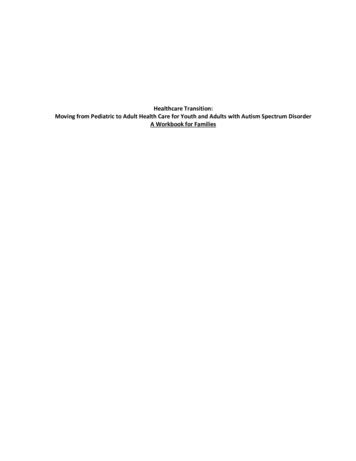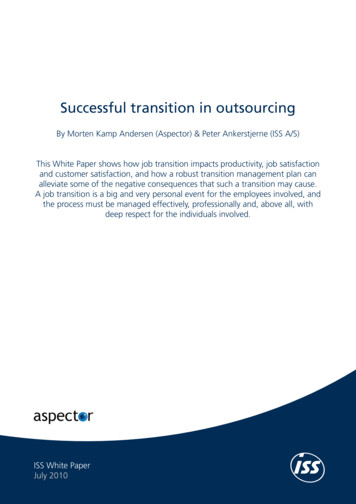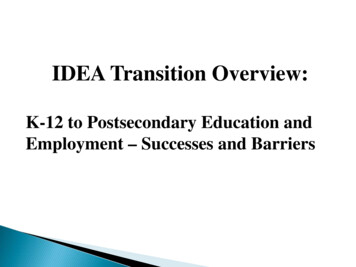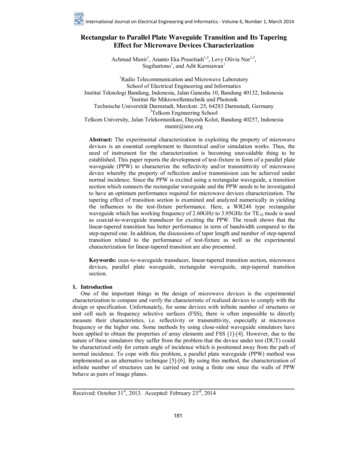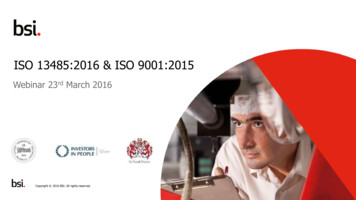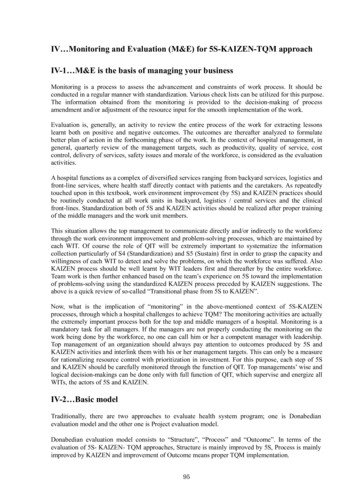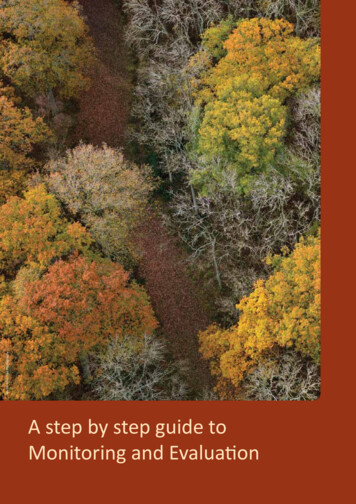
Transcription
Photo: Mim Saxl PhotographyA step by step guide toMonitoring and Evaluation1
CreditsThis resource wasdeveloped as part of theProject ‘Monitoring andEvaluation for SustainableCommunities’ ojects/monitoringandevaluation.html) funded by the HigherEducation Innovation Fundat the University of Oxford,and builds on ongoing workundertaken as part of theongoing research project‘EVALOC: Evaluating Lowcarbon communities’ project(www.evaloc.org.uk/ ).Monitoring and Evaluationfor Sustainable Communitiesby jects/monitoringandevaluation.html is licensed undera Creative CommonsAttribution-NonCommercialShareAlike 3.0 UnportedLicense.Version 1.0 PublishedJanuary 2014.2ContentsSection 1: Explanatory notes3Background3Using the resources3What is Monitoring and Evaluation5Why do M&E 6Agreeing some guiding principles6Deciding which programmes to monitor7Deciding who to involve 7Deciding key issues7Clarifying your aims 8Identify information you need10Deciding how to collect the information13Assessing your contribution14Analysing and using the information16Communicating the data17Ethics and data collection17Annexes to Section 11. An example of a change pathway2. Example of activity monitoring3. Examples of resilience indicators4. Examples of headline indicators5. Dealing with complex change1819202122Section 2: Planning your M&EA framework to help you plan your strategy for M&E24Section 3: Information collection methodsInternal recordsTracking relevant secondary informationGroup workshopsShort surveysSemi-structured interviews333333343536Section 4: Overview of resourcesThe best of what’s aroundStart where you areCommunity and household footprintingEvents and SurveysGroup processesOther online sources of informationDesigning survey questionsGroup evaluation toolsVisual tools for discussionRoles mappingDiscussion373738394142434444464748Section 5: Useful questions for interviews/surveys49
A step by step guide to Monitoring and EvaluationIntroductionThis resource is designed to help groups working on community led approaches to climate changeand energy conduct their own Monitoring and Evaluation (M&E). It aims to provide an accessiblebackground to the principles of M&E, together with selected links to resources and approaches thatmay be useful for your group.BackgroundThese resources were trialled at two workshops that took place in June 2013, and were attendedby representatives from 25 different community groups working on energy and climate change. Theworkshops built on interviews with 10 community groups; a wider survey on M&E experiences andneeds; and the authors own experiences of M&E through research and practical experience withand in community groups.The selection of resources below responds to an identified dearth of comparable evidence acrosslow carbon/community energy movements. While the aim is to combine ease of use with theproduction of useful outcomes, the list of resources is by no means exhaustive, as resources andmethods are constantly evolving.Using the resourcesThe booklet is divided into sections. Section 1 gives an overview of the approach to M&E inuse, which is based on a logic model approach. Section 2 is a template for your own M&Eresources. As a pdf format, you can print this out, or type into it. You can also download theresource as a word document at: jects/monitoringandevaluation.html3
Section 3 gives an overview of information collection methods, whilst section 4 provides links toa host of resources to support your M&E. Finally, section 5 contains some example questions andmaterials.This material is a work in progress, as during 2014 there will be further trialling of a selection ofM&E tools with community groups. You can read more about the project s/projects/mesc/Thanks are extended to the groups who were interviewed for this project, who participated in theworkshops, and/or gave their feedback on the resources. Thanks also to the Transition ResearchNetwork, and their Connected Communities Arts and Humanities Research Network project for theinitial collaborative impetus for this project. Finally, gratitude is extended to the Transition Network,and the Low Carbon Communities Network for partnering with the project.Photo: Mim Saxl PhotographyKersty Hobson, Ruth Mayne, Jo HamiltonDecember 20134
A step by step guide to Monitoring and EvaluationSection 1: Explanatory notesWhat is Monitoring and Evaluation (M&E)?Monitoring is the collection and analysis of information about a project or programme, undertakenwhile the project/programme is ongoing.Evaluation is the periodic, retrospective assessment of an organisation, project or programme thatmight be conducted internally or by external independent evaluators.A broader way of thinking about M&E is Action ResearchAction Research is a term for a variety ofmethodologies that at their core are cycles ofplanning, action and reflection. This is a usefulapproach when thinking about how to integrateyour M&E into on-going plans and activities.There are many Action Research methodologieswhich could be used as part of your M&E. A goodoverview and resources can be found at theAshridge Centre for Action Research1 Particularmethods that you may find useful are Cooperative Inquiry2 and Appreciative Inquiry3.1. Why do M&E?The first step is to be clear about why you want to do M&E and the benefits it can offer.Community volunteers and activists often want to make the world a better place, making themaction-orientated and often under-resourced. Monitoring and evaluation can sometimes seemlike an unaffordable luxury, an administrative burden, or an unwelcome instrument of externaloversight. But if used well, M&E can become a powerful tool for social and political nt.nsf/wFARACAR/Ashridge Centre for Action tro/default.cfm5
‘We use the monitoring data from ourhousehold energy saving project to motivateother residents to take action. The informationalso helped us demonstrate the effectivenessof our approach to the local council whichsubsequently got funding and worked with us toset up a Community Hub to support other localcommunities to take action’(Low Carbon West Oxford4 volunteer)Doing M&E can help you assess what difference you are making and can provide vital intelligence,for example to help you: assess and demonstrate your effectiveness in achieving your objectives and/or impacts onpeople’s lives;improve internal learning and decision making about project design, how the groupoperates, and implementation i.e. about success factors, barriers, which approaches work/don’t work etc;empower and motivate volunteers and supporters;ensure accountability to key stakeholders (e.g. your community, your members/supporters,the wider movement, funders, supporters);influence government policy;share learning with other communities and the wider movement;contribute to the evidence base about effectiveness and limits of community action.2. Agreeing some guiding principlesIt is useful to develop some guiding principles to ensure that your M&E is relevant, useful, timely,and credible. Some examples might include making sure the M&E and/or information you collect is: 46focused and feasible in relation to your available resources so that it supports rather thandiverts resources from action (i.e. make sure you focus information collection on what you‘need to know’, not on what would be ‘nice to know’);useful and timely information to improve group learning, group decision making, andproject design;useable by, and/or comparable to, data collected by other stakeholders so it contributes tothe wider evidence base;credible, valid and reliable to the extent possible within your available resources;sensitive to unequal power relations when you collect information (i.e. ensure that youlisten to people who might be marginalised in the community or do not have a strong voice);ethical e.g. in relation to data consent and protection.http://www.lowcarbonwestoxford.org.uk/
3. Deciding which programmes/projects you need to monitorIt is important to decide and prioritise the programmes or projects you will monitor as it is unlikelyyou will have the resources to monitor all your interventions at the same time. So you will needto think about which programmes or projects you want to assess; overwhat time period; and whether it is an on-going activity which requiresmonitoring or a completed activity which requires evaluation.4. Deciding who to involve in the differentstages of your M&ETo ensure M & E is relevant to your stakeholders it is important thatyou consider their information needs, as well as your own. You willtherefore need to identify the key internal and external stakeholders,and decide how to involve them in the design, implementation, analysisand/or communication of findings.Examples of people you might want to include are (a) people directlyinvolved in your projects (b) stakeholders in your wider community(geographic or community of interest) such as specific groups ofresidents, specific networks, community groups, the wider movement,and/or (c) external stakeholders e.g. funders, local and national policymakers. It might also be possible to work in partnership Universitydepartments. For useful background information about working withUniversity researchers, see the Transition Research Network5 , and theTransition Research Primer6.5. Deciding the key issues and questions you will want toinvestigateThe next key step is to identify the issues and questions you wish to learn about, and hence monitor.These often include:Issues and questions internal to your group Organisational capacity/group processes – how well are you working together in relation tothe following?:needed resources (human, financial, technical)leadership and visionmanagement (e.g. clarity about aims, objectives, roles & responsibility; adaptability)cost effectivenesssustainability (e.g. finance and/or volunteer burn out) Joint working – how well are you working with others, for examplein relation to partnerships, the wider movement, alliances, coalitionsdisseminating or sharing good practice and tion-research-primer.html7
Issues and questions external to your group Relevance/acceptability - how relevant are your projects to different demographic sectionsof the community? Effectiveness - are you achieving your objectives (e.g. in relation to attitudes & values;behaviours; public support; community capacity/local resilience; the wider movement;improved policies & increased democratic space)? What internal or external factors arefacilitating/constraining progress? Impact - what is your impact on people’s lives (e.g. in relation to the ultimate changes inpeople’s lives or environment as a result of our initiatives)? Contribution/attribution - what contribution have you made to outcomes and impacts (inrelation to other factors/actors)?You will need to decide whether or not to monitor or evaluate all of these questions or just some.This is likely to require balancing information needs with available resources.6. Clarifying your aims, objectives, activities and pathways tochangeDefinitionsIn order to assess progress you need to know what you are trying to achieve and how: that is, youraims, objectives and planned activities. As this is not a planning guide we cannot go into detail hereabout how to develop your strategy, but it is generally helpful to start by clarifying your aims andobjectives (i.e. your desired impacts and outcomes) and then plan the activities that you (and otheractors) will carry out to achieve them.Table 1 – Key concepts & definitions in project design & strategyConceptAims ActivitiesInputs8DefinitionThe final impacts on peoples’lives or the environment that youwish to achieveExampleTo reduce our individual and communitycarbon emissions & contribution to climatechange; to contribute to a fairer, moreprosperous and sustainable community; toimprove well-beingThe changes you need to makeTo increase personal agency; to encourageso that you achieve your aimsmore sustainable living/behaviours; to(desired impacts)increase community resilience/capacity towithstand external shocks; supportive andfair government policiesThe immediate and direct result To engage X participants in projects/of your activities that contribute events/training from y and z demographicto your objectives (desiredgroups; to plant X trees, to facilitateoutcomes)swapping of Y items at a Bring & Take eventCommunity engagement & awarenessThe programme & projectactivities and processes youraising; action/learning groups onundertake so that you achievehousehold energy use & lifestyles;community food, transport, wasteyour desired outputsreduction projectsThe key human, financial,Volunteer capacity and availability; accesstechnical, organisational and/or to IT and other online resources; fundsocial resources that you need to raised and availableundertake your activities
Photo: Mike GrenvillePathway to changeAlthough change can be complex it can be helpful to present your programme and strategy inthe form of a change pathway, or an impact chain. This describes how your project activities willcontribute to your desired outcomes (your objectives); which will in turn contribute to final impacts(your aims). A simplified impact chain looks like this:In practice your impact chain is unlikely to be linear: there may be multiple outcomes and impactsand there may be interactions and feedback loops between different parts of the pathway. Wehave provided an illustrative example of an impact chain in Annex 1 and drawn out some of theimplications of complex and unpredictable change for M&E in Annex 5.Change AssumptionsA change pathway/ impact chain can be useful because it reveals the interrelationships betweenactivities, outcomes and impacts and therefore also your change assumptions or theory about howyou think change will be achieved. These assumptions are often implicit rather than explicit soyou may not even be aware of them. If you haven’t already done so it’s worth taking time in yourgroup to discuss them to see whether you are all in agreement, whether they seem plausible, and/or whether you might need to investigate them more. You could test them against existing theoriesof change, evidence and/or your practical experience or the experience of other groups. The morewell-founded your change assumptions at the start the greater your impact is likely to be.The box below provides a simple example of the impact chain and change assumptionsunderpinning a community awareness raising project:Table 2 – Examples of change assumptionsProject designAims:To reduce our individual &community’s contributionto carbon emissionsObjectives:To change people’sbehavioursPlanned activitiesProviding residents withinformation via leafletsand community eventsDesired changesDesired impacts:Reduced household &community energy use/carbon emissionsDesired Outcomes:More sustainablebehaviours amongresidentsDesired InterimOutcomesIncreased ‘residentsawareness’ aboutclimate changeChange assumptionsHow outcomes will lead to impactsOur project design assumes that if peoplechange their energy (related) behavioursthis will reduce their carbon emissionsHow activities will lead to desiredoutcomesOur project design assumes that:a) if people understand climate changethey will change their behaviours; andb) the community group is a ‘trusted’messenger that people will listen to9
The above example assumes that raising awareness aboutclimate change will change peoples’ behaviours and hencereduce carbon emissions. In practice there are factors otherthan peoples’ awareness that influence behaviour such asagency, capacity, resources, social norms, infrastructures,technologies, cultural norms and government policy. Thereforea project based solely on this change assumption runs the riskof not meeting desired outcomes. Conversely communitygroups are sometimes hugely ambitious and assume they havethe capacity to achieve their objectives when in fact changegenerally requires action by a range of actors. Mapping outyour change pathway and identifying your change assumptionscan help you work out what contribution you can make andwhat contributions other actors need to make.As well as helping you track outcomes and impacts, M&E canalso help you test how well founded your change assumptionsare, and whether you need to modify your project design. Inthe example above, you might decide to interview participantsafter an event or course, and ask them open questions aboutwhat factors they think might help and/or constrain themfrom changing their behaviours, as well as which sources ofinformation they trust, such as organisations, websites and themedia.7. Identifying what information you need to collectGenerally you are likely to need information to: Track and assess what has changed (both intended and unintended); Understand the reasons for changes - i.e. what factors/organisations/individuals havefacilitated/constrained change (including your contribution); Interpret the changes i.e. people’s perceptions and experiences of change.The information you collect might either be Quantitative information expressed in numerical terms as numbers and ratios for example.This information will allow you to answer ‘what’, ‘how many’ and ‘when’ questions. Qualitative information is expressed through descriptive prose and can address questionsabout ‘why’ and ‘how’, as well as perceptions, attitudes and beliefs.The precise information you need will be determined by your choice of key issues and question (seeTable 3 below).IndicatorsIf you want to track intended changes resulting from your programmes or projects you will need toidentify indicators. These are specific and concrete pieces of information that enable you to trackthe changes you are trying to achieve.10
If, for example, if you have chosen to assess your effectiveness (i.e. the extent to which you areachieving your objectives) or impacts you will need to identify and track relevant ‘outcome’ and‘impact indicators’. An example of an outcome indicator might be changes in residents’ energyrelated behaviours e.g. the number of residents cycling, using the train or car club. An exampleof an impact indicator might be changes to residents’ fuel bills, household energy use and carbonemissions (see table 3 below).You need to make sure that indicators are relevant, specific (and where possible measurable), andare timetabled to be gathered at key points in a project or programme7. Also importantly, indicatorsneed to be accompanied by open ended questions (see below). Taken together this informationshould provide credible evidence of changes associated with your activities.Photo: SEAD/TrapeseYou may find it is not desirable or possible to monitor all yourdesired outcomes and impact indicators on a continual basis.Small projects or programmes may only have a limited influenceover some outcomes or impacts compared to other factors; theoutcomes or impacts might only occur in the longer term; and/or it can be difficult and expensive to try and assess them onyour own. If you can afford to, you may want to conduct externalevaluations or work with academics to conduct periodic in-depthevaluations. However, the ease or difficulty of tracking outcome orimpact indicators will vary. You may be able to use modelled dataor conversion factors to estimate impacts from outcomes e.g. toestimate the health benefits generated from loft insulation, or thecarbon savings from eating less meat.Tracking activities and outputs can give a useful indication of yourcapacity and reach and can also be used as valuable information for evaluations (see Annex 2 and 3below). You might also use be able to use conversion factors or modelled data to estimate outcomesfrom some of your outputs. For example, you can work out the amount of carbon emissionssaved from the numbers of trees planted or the health benefits from warmer homes. However,tracking outputs on their own does not tell you what difference you are making in relation to theachievement of your objectives (outcomes) or to people’s lives (impacts).Open questionsIt is also important to try to capture unintended changes, to understand the reasons for change,and to interpret the changes. To do this you will also need to ask open ended questions includingquestions which explore why and how changes have happened and what they mean to people (alsosee Section 9 and Annex 5 below). This may yield both quantitative and qualitative data.Ideally you should collect information about the situation before the project started (baseline data)so you can see what difference the project has made (see “Section 4: Overview and resources”on page 37). If it is not possible to collect baseline data before your project starts you cansometimes collect it retrospectively e.g. by asking people to compare the situation before and afterbut the data is likely to be more prone to error.In the box overleaf we summarise some possible indicators relating to the key M&E questionsidentified above:7Some M & E guides recommend that objectives, and hence indicators, are SMART (Specific, Measurable, Attainable,Relevant and Time-tabled). However, making all objectives measurable and attainable can be unduly limiting e.g. someobjectives may be aspirational or longer term: or may involve qualitative changes which cannot be easily quantified.11
Table 3 Examples of Indicator themesNote: these are example of possible indicator themes, rather than precise indicators, and are by nomeans a complete list. See Annex 3 for further examples.Key issues/questionsIndicators: changes in ( or -):Issues/question internal to group(s)Organisational capacity/group Access to resources (human, financial, technical); leadership,processesvision and understanding of change; management (e.g.clarity about aims, objectives, roles & responsibility; workingprinciples; adaptability); cost effectiveness; sustainability (e.g.finance, and/or supportive framework for volunteers)Cost effectiveness/efficiencyRatio of cost (including volunteers’ time) to outcomes (e.g.amount of energy efficiency measures installed/energyreduction achieved)Joint or partnership workingPerceptions of value added from working together; early wins;shared vision, objectives, strategy & working principles; clearroles & responsibilities; trust; recognition of value of differentcontributionsIssues/questions about outputs, outcomes and impactsRelevanceNumbers, percentage and demographic mix of projectparticipants; perceptions of participants and wider communityabout relevance of projects to their lives and needsEffectiveness (interim outcomes and impacts )Hearts & mindsIndividual and community attitudes/beliefs/values e.g. thatclimate change is/is not caused by human activity; or thatincreasing resilience/reducing CO2 is/is not the right thing todoIndividual agency/People’s beliefs that they can take meaningful action and thatempowermentchange is possible (e.g. might include motivation, knowledge &skills, intention/commitment, capacity)Behaviours/practicesMore sustainable behaviours (e.g. closing windows, turningoff lights when not in use, drying laundry naturally rather thantumble drying, using public transport rather than the car)Community capacity/resilience Community resources (human, technical, and financial); networks/partnerships/collaborations; residents access to and consumptionof locally grown food, clean energy, water and other resources;use of local currency or exchange schemes; number of localbusinesses/social enterprises/jobs (see Annex three for furtherexamples)Social capitalIncreased interaction between individuals, groups and sectorsin community, trust, pro-social & environmental normsSupport base/participation inNumbers of members/supporters participation in initiatives;activities/public supportmotivations for participation/non-participation; trust incommunity organisation/movementParticipation in and/orInvolvement in public decision making (including access to info,influence over local andmeaningful consultation, responsiveness of decision makers tonational decision making andlocal people); involvement in petition/lobbying/campaigningpoliciesof national government; changes in relevant policies (e.g.the terms of debate; getting issue on policy agenda; policycommitments to change)12
ImpactsEnergy use & carbon emissions Household & community energy use & carbon emissionsSocial well-beingHealth (e.g. relating to warmer homes, active lifestyles, healthierfood and connection with other people)Economic well beingHousehold - Financial savings on bills, wages, economic securitynew jobs; skills; access to resources/assets/markets; economicsecurityCommunity – Assets, income stream, jobs created, skills/ trainingopportunitiesEquityDistribution of costs and benefits e.g. who benefits and who paysfor changesContribution/AttributionPerceptions of a range of different stakeholders about thecommunity groups’ contribution to changes (or randomisedcontrol groups to track changes happening without interventionfrom projects or programmes)NB. Tracking indicators on its own does not tell you what contributions you have made to anyobserved changes. To find this out you will need to ask additional questions (see section 9 below oncontribution/attribution).8. Deciding how you will collect the informationInternal monitoringFor each indicator you will need to work out how you will collect theinformation i.e. your information collection methods (see “A step by stepguide to Monitoring and Evaluation Section 3: Information collectionmethods” on page 33). Generally it is preferable to collect datafrom a range of internal and external sources. Some useful informationcollection methods for internal monitoring include: Internal records to track project activities, processes and outputindicators; Keeping records of relevant secondary information to trackchanges in outcomes and impacts and accompany internalrecords, such as policy changes, media coverage, relevantsurveys/databases Periodic group workshops, discussions, focus groups (includinggroup ratings/ranking exercises and/or other visual techniquessuch as time lines, mapping, diagrams; other diagnostic tools) Periodic surveys (e.g. to assess attitudes, event feedbacks and/orbehaviour change) Use of automated household or community tools, modelled dataor conversion ratios e.g. carbon calculators such as DECoRuM8.8DECoRuM is a GIS-based toolkit for carbon emission reduction planning with the capability to estimate current energy-related CO2 emissions from existing UK dwellings, aggregatingthem to a street, district, sub-urban, and city level.13
Table 4 Example of indicators & information collection methodsIssue/question & indicatorsNumbers, percentage anddemographic mix of projectparticipants; perceptions ofrelevance by participantsInformation collection method Frequency (including nt questionnaireOnce at beginning of projectCommunity questionnaireEvery 3 yearsEffectivenessAgency; perceptions of socialnorms; household energybehavioursParticipant questionnaireAt beginning & end ofprogrammeImpactsHousehold energy useMeter readingsMonthlyHousehold carbon emissionse.g. Quicksilver CalculatorCommunity Energy UseElectricity Network operator ifavailableAt beginning of programme(for preceeding year) and atend of programmeAnnuallyCommunity Carbon Emissionse.g. DECoRuM mapping orother community scale carboncounting toolsAnnuallyEvaluationsYou can either conduct your own evaluations or commission an independent external person todo it for you. External evaluations can be more useful as interviewees may be more likely to talkopenly to them, however they can be expensive unless they are conducted by funded academicresearchers (see the Transition Research Network, and the Transition Research Primer). Externalevaluators can use the information collected by the internal monitoring system but may alsoneed to supplement this with other information collected from a range of internal and externalstakeholders e.g. from group workshops, semi structured interviews and/or surveys.9.Assessing your contribution/influenceYour M&E may show positive outcomes and impacts associated with your projects and programmesbut this may be attributable to other factors or actors (individuals or organisations) rather thanyour programme or projects. Therefore an important part of M&E is assessing the influence orcontribution your projects/activities have made to any observed outcomes or impacts.14
Photo: Mike GrenvilleRandomised controlsFor some academics and policy makers, the only objective way to assess attribution is throughsurveys over a defined period of time, which compare changes in the communities taking part inthe project to changes in communities who are not taking part in the project (either a randomisedor purposively selected control group). Any differences in outcomes or impacts can then be arguedto have been caused by the project. However, this requires resources beyond the reach of manycommunity groups. Therefore, unless you are able to collaborate with academics (see the TransitionResearch Network9 and the Transition research marketplace10) or others, this might not bepossible. It can also raise some technical and ethical issues about the difficulty of finding controlcommunities and/or withholding or denying support to control communities. Alternatively
Monitoring and evaluation can sometimes seem like an unaffordable luxury, an administrative burden, or an unwelcome instrument of external oversight. But if used well, M&E can become a powerful tool for social and political change. A broader way of thinking about M&E is Action Research A step by step guide to Monitoring and Evaluation
